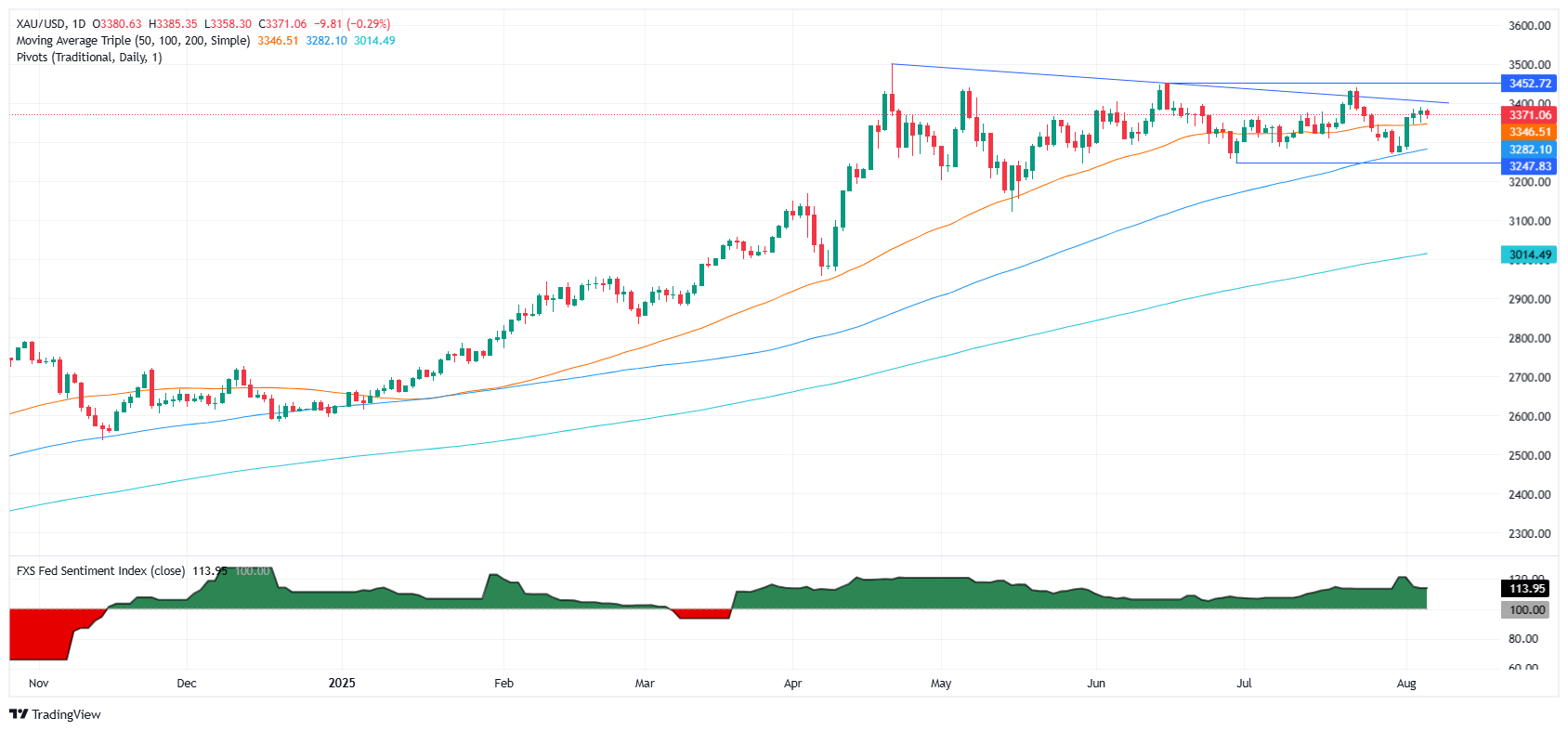Gold price retreats as US yields rise and traders book profits
- Gold price down 0.23% to $3,372 amid profit-taking and higher US Treasury yields.
- 10-year yield climbs to 4.24%, weighing on non-yielding assets like Gold.
- Fed rate cut odds for September remain near 87%; 58 bps of easing priced for 2025.
Gold price retreats in the North American session, weighed down by rising US Treasury yields, traders booking profits, and news that US President Donald Trump might name Fed Governor Adriana Kugler’s replacement toward the end of the year. The XAU/USD trades at $3,372, down 0.23%.
Bullion faltering to extend its rally, which extended for three days, is also attributed to traders booking profits, even though US President Donald Trump signed an executive order adding a 25% levy on India as the latter continues to purchase Russian Oil. India’s new tariff, effective 21 days after August 7, would raise duties on some of its exports to as high as 50%.
In the meantime, US Treasury yields are climbing, with the 10-year at 4.241%, up three bps so far in the day, a headwind for XAU. Conversely, the US Dollar Index (DXY), which tracks the performance of the buck’s value against a basket of six peers, is down 0.50% at 98.25.
Expectations that the Federal Reserve (Fed) will cut interest rates at the September meeting remain at around an 87% chance, according to the CME FedWatch Tool. The December 2025 fed funds rates contract shows that market participants expect 58 basis points (bps) of easing toward the end of the year.
A scarce economic docket left traders adrift to comments by Boston Fed President Susan Collins, San Francisco Fed Mary Daly and Governor Lisa Cook.
Daily digest market movers: Despite falling, Gold seems poised to extend its rally on US trade news uncertainty
- US July ISM Services PMI fell from 50.8 a month ago to 50.1, missing estimates for a rebound to 51.5. Although the index clung to expansionary territory, the employment sub-component contracted further, while the Prices Paid Index hit its highest level since October 2022. The stagflationary signs of the report pushed the US 10-year/3-month yield curve further into negative territory, an indication that investors have priced in an economic slowdown.
- Although Bullion remains negative on the day, uncertainty about US President Trump's trade policies would keep the yellow metal underpinned. Recently, Trump claimed that the European Union (EU) would face 35% duties if the bloc did not invest in the US. In the US/EU agreement, the latter promised $600 billion in investment and $750 billion of purchases of US energy.
- On the geopolitical front, Trump is preparing to impose fresh sanctions against Russia’s shadow fleet if Russian President Putin does not agree to a ceasefire in Ukraine by Friday.
- Citi updated its Gold forecast for the next three months from $3,300 to $3,500 per troy ounce on Monday. They mentioned in the note that “US growth and tariff-related inflation concerns are set to remain elevated during 2H’25, which, alongside a weaker dollar, are set to drive gold moderately higher, to new all-time highs.”
XAU/USD technical outlook: Gold dips as sellers test the 20-day and 50-day SMA confluence
Gold (XAU/USD) is trading near nine-day highs, consolidating below the $3,380 mark after breaking above the confluence of the 20- and day50-day Simple Moving Averages at $3,344/$3,349 and reclaiming the $3,350 level. While the short-term bias has improved, the broader uptrend is being capped by the $3,400 mark, which, if cleared, opens the path to test the July 23 high of $3,438, potentially paving the way toward the June 16 peak at $3,452.
On the downside, a drop below $3,350 would expose initial support at $3,300, followed by the 100-day SMA at $3,267.

Gold FAQs
Gold has played a key role in human’s history as it has been widely used as a store of value and medium of exchange. Currently, apart from its shine and usage for jewelry, the precious metal is widely seen as a safe-haven asset, meaning that it is considered a good investment during turbulent times. Gold is also widely seen as a hedge against inflation and against depreciating currencies as it doesn’t rely on any specific issuer or government.
Central banks are the biggest Gold holders. In their aim to support their currencies in turbulent times, central banks tend to diversify their reserves and buy Gold to improve the perceived strength of the economy and the currency. High Gold reserves can be a source of trust for a country’s solvency. Central banks added 1,136 tonnes of Gold worth around $70 billion to their reserves in 2022, according to data from the World Gold Council. This is the highest yearly purchase since records began. Central banks from emerging economies such as China, India and Turkey are quickly increasing their Gold reserves.
Gold has an inverse correlation with the US Dollar and US Treasuries, which are both major reserve and safe-haven assets. When the Dollar depreciates, Gold tends to rise, enabling investors and central banks to diversify their assets in turbulent times. Gold is also inversely correlated with risk assets. A rally in the stock market tends to weaken Gold price, while sell-offs in riskier markets tend to favor the precious metal.
The price can move due to a wide range of factors. Geopolitical instability or fears of a deep recession can quickly make Gold price escalate due to its safe-haven status. As a yield-less asset, Gold tends to rise with lower interest rates, while higher cost of money usually weighs down on the yellow metal. Still, most moves depend on how the US Dollar (USD) behaves as the asset is priced in dollars (XAU/USD). A strong Dollar tends to keep the price of Gold controlled, whereas a weaker Dollar is likely to push Gold prices up.






